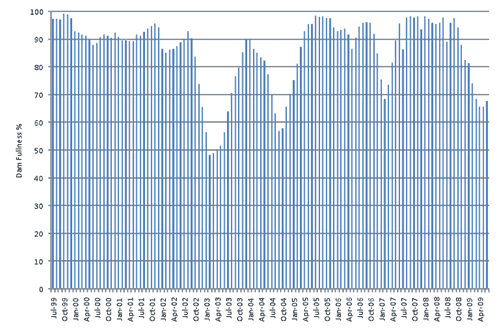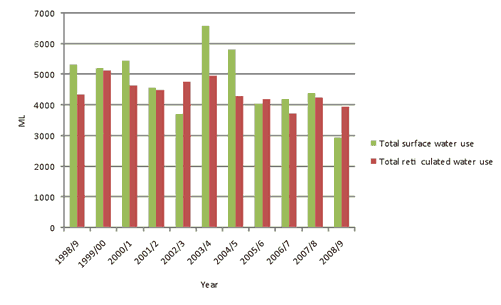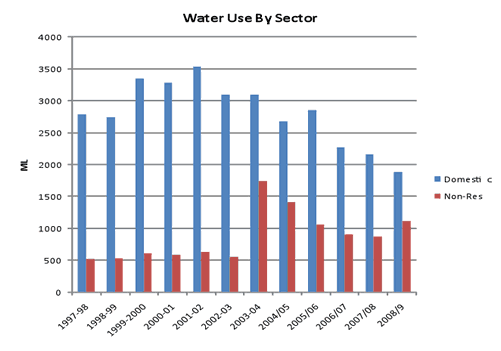Eurobodalla
Indicator: Water Use
Results for this indicator are also available for [an error occurred while processing this directive]
Please note: Text or data highlighted in this colour represent an update to this indicator for the period 2008/09.
What the results tell us for the Eurobodalla Shire
The Eurobodalla coastal area is vulnerable to droughts, though in most years the rainfall is adequate to ensure a water supply without restrictions. During the peak of the recent drought the Deep Creek storage dam fell to a minimum of about 50% of capacity.
Domestic water use has reduced by 38% over the years 2002 to 2007 due to a combination of factors including water restrictions, education, incentives and use of recycled effluent. Non-residential use also fell over the four years between 2004 and 2008 by about 50%. The drinking water supply appears adequate at the present, but the predicted effect of climate change is likely to reduce the rainfall in South Eastern Australia. This may result in more periods of water restrictions and the long-term need to plan for increased drinking water resources, especially as population increases.
During this reporting period these issues were partially addressed through the initiation of development of the Moruya River to Deep Creek supply pipeline, and the detailed planning of a new water treatment plant at Deep Creek Dam.
Supply- how much water could we have?
Data are available for Eurowater, the overall Council area’s drinking water supply, and for the independent sources forming the supply. These are drawn from the Buckenboura River, Deep Creek Dam, Dromedary Weir (this is no longer used, but is still online for use during extreme drought events), Moruya River and Tuross River. Deep Creek Dam, Buckenboura River and Moruya River supply water to the whole shire, the Tuross River supplies water to Narooma and the villages south including Bodalla, and Dromedary Weir supplies drinking water to Central Tilba (see above). The population supplied is 34,660, with the largest numbers in Batemans Bay (10,200) Narooma (4,300) and Moruya (3,300).
The only water supply reservoir in the system is Deep Creek Dam, which is an off-river storage with no catchment, located near Batemans Bay. Deep Creek Dam has a storage capacity of 4,900 ML, and water is sourced primarily from the Moruya River. The other water sources are direct from rivers. The NSW Government licenses the overall quantity of extraction from water sources.
The graph below (Figure 1) shows the dam water availability over the period of August 1999 to June 2009. It is apparent that the storage was drawn down to meet the requirements for the reticulated supply in 2003, 2004 and 2005, with minimum levels of 48% in February/ March 2003, 57% in September/October 2004 and 68% in February 2007. The storage dropped to approximately 66% during 2008-09. This reservoir is a holding storage to buffer the supply drawn from the surface waters of the Buckenboura and Moruya Rivers. Demand on this system fluctuates with season and rainfall, an increased demand being in summer with the much larger population of holidaymakers.
Figure 1. Dam water availability in Eurobodalla Shire Council area July 1999 to June 2009

Figure 1 was updated to include data for 2008-09.
Consumption – how much water was used.
Figure 2 below illustrates the overall water used by the Eurowater Supply system, on an annual basis.
Figure 2. Total water use in Eurobodalla Shire Council area 1998-99 to 2008-09

Figure 2 was updated to include data for 2008-09.
Use by sector
Figure 3. Water use by sector – Eurobodalla Shire Council area 1997-98 to 2008-09

Figure 3 was updated to include data for 2008-09.
Residential use is the largest component of reticulated water use, followed by the non-residential sector. Residential water use was highest in 2001-2002 at 3,500 MLA per year. This reduced to approximately 1850 ML in 2008-2009, a decrease of 47%.
A major reduction in non-residential water use occurred between 2003-2004 (when use was at about 1,700 ML/Yr) and the period from 2006 onwards. By 2008-2009 use dropped to the order of 1150 ML, a reduction of 32% against the 2003-04 level.
Under current arrangements, pumping from the Moruya River to the Deep Creek Dam can only take place during times of medium flow. This is because the Shire has no advanced water treatment facilities that are designed to cope with sediment and other issues. This means that the impact of pumping on the river can be significant, as periods of drier weather and lower flows often coincide with high use holiday periods.
During this reporting period these issues were partially addressed through the initiation of development and commencement of construction of the Moruya River to Deep Creek supply pipeline, and the detailed planning of a new water treatment plant at Deep Creek Dam. Combined, these will allow pumping of water from the Moruya River during high flow events, thereby reducing the ecological impact of water pumping on the river system. Both of these initiatives are being undertaken as part of the implementation of Council’s Integrated Water Cycle Management Strategy.
Managing water demand and use
Water conservation
Water restrictions were imposed throughout 2003-2004, and then intermittently up to 2007-2008 when no restrictions were in place. The most severe restrictions were 365 days in 2002-2003 and 153 days at Level 3 and 160 days at Level 1 in 2004-2005. Level 1 restrictions were introduced in November 2008 and increased to Level 2 restrictions in March 2009. All sets of restrictions had a visible effect on reducing water use.
Council has also run a “Water Saving Incentive Scheme” over the reporting period as part of its program to manage water demand. This program has a number of components including the provision of free showerheads (and energy efficiency lightbulbs), rebates for the installation of domestic rainwater tanks and rebates for the purchase of water efficient washing machines. The showerhead component of the program ended during the first half of 2007 as these services were being provided by private companies to households at no cost. The rainwater tank and washing machine rebate components of the program continue and have been extended beyond their initial completion dates and have continued after the end of this reporting period.
Treated wastewater was used for irrigation of golf courses, from standpipes and for on-site work. Over most of the reporting period, the amount of wastewater reused has been under 10%, although this figure increased significantly in 2006-2007 to 15%. EuroWater is aiming to increase this use of wastewater significantly into the future.
Laws and policy
Eurobodalla Shire is located entirely within the Southern Rivers Catchment Management Authority area.
About the data
Quantitative data were received from the Eurobodalla Shire Council.
